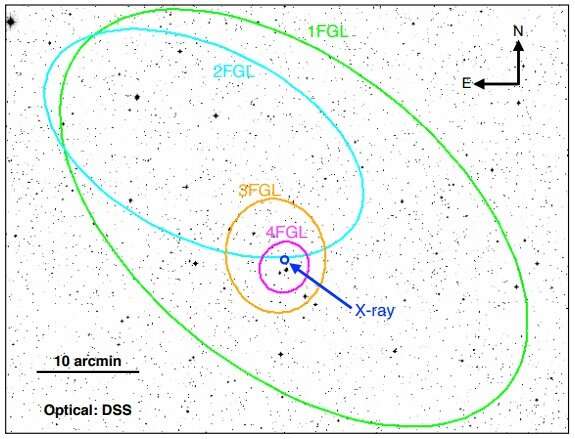January 27, 2021 report
Astronomers discover new candidate redback millisecond pulsar

Astronomers report the finding of a new candidate redback millisecond pulsar (MSP) binary associated with a gamma-ray source known as 4FGL J0940.3–7610. The newly found object is a short-period compact binary exhibiting X-ray emission that consists of a low-mass neutron star and a companion star with a mass most likely over 0.4 solar masses. The discovery is detailed in a paper published January 21 on the arXiv pre-print server.
The most rapidly rotating pulsars, those with rotation periods below 30 milliseconds, are known as millisecond pulsars. Researchers assume that they are formed in binary systems when the initially more massive component turns into a neutron star that is then spun up due to accretion of matter from the secondary star.
A class of extreme binary pulsars with semi-degenerate companion stars is dubbed "spider pulsars." These objects are further categorized as "black widows" if the companion has extremely low mass (less than 0.1 solar masses), while if the secondary star is heavier they are called "redbacks."
Now, a team of astronomers led by Samuel J. Swihart of the Michigan State University (MSU) reports the detection of an X-ray and variable optical source that is most likely a new redback MSP binary. The discovery is based on the data obtained with NASA's Swift spacecraft and Southern Astrophysical Research (SOAR) telescope in Chile.
"We have discovered a new candidate redback millisecond pulsar binary near the center of the error ellipse of the bright unassociated Fermi-LAT gamma-ray source 4FGL J0940.3–7610," the scientists wrote in the paper.
The results show that the companion is a low-mass star (late-G to early-K type dwarf star) orbiting an invisible primary every 0.27 days. The object showcases ellipsoidal variations and irradiation, consistent with the properties of other known redback MSP binaries.
According to the study, the observed MSP binary has a neutron star with a mass of around 1.2-1.4 solar masses, while the mass of the secondary star turns out to be greater than 0.4 solar masses. The system has an edge-on inclination and is estimated to be some 7,500 light years away from the Earth.
The astronomers noted that the system's inclination and properties of the companion star could make radio eclipses more likely for this system, what explains its previous non-discovery during radio pulsation observations. This makes 4FGL J0940.3–7610 a strong candidate for a focused search for gamma-ray pulsations.
In concluding remarks, the researchers note that although all the collected data support the redback classification, further studies are necessary in order to confirm this hypothesis.
"Although all the available evidence points towards a redback classification, this needs to be confirmed with additional data. Ultimately this requires a detection of a pulsar in either radio or gamma-ray observations," the authors of the paper concluded.
More information: Discovery of a New Redback Millisecond Pulsar Candidate: 4FGL J0940.3-7610, arXiv:2101.08776 [astro-ph.HE] arxiv.org/abs/2101.08776
© 2021 Science X Network





















